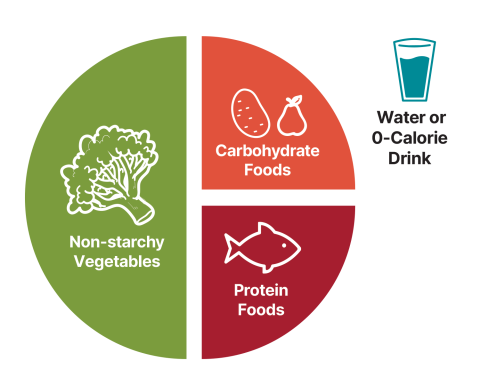Healthy eating for prediabetes and diabetes not only helps to manage your blood glucose (blood sugar), it also helps you have a better relationship with food. When you nourish your body with quality foods, it helps your body function at its best.
How to Make Healthy Eating Choices
Informed food choices are essential to living well. Food fuels the body and is a key part of diabetes management. However, no matter what eating plan you follow, there are some basic guidelines that apply across the board.
What all healthy eating plans have in common:
- Non-starchy vegetables as a foundation for the plate
- Lean proteins and plant-based sources of protein
- Quality carbohydrates like starchy vegetables, fruits, whole grains, and low-fat milk
- Less added sugar
- Healthy fats
- Less processed foods
- Water or zero-calorie beverages
Use the Diabetes Plate for Meal Planning
Simplify healthy eating with the Diabetes Plate— a low-carb meal pattern jumpstart that helps you portion your plate and support your diabetes management. This simplified way to approach meals is easy to customize to your food preferences.

Start with a nine-inch plate and fill half with non-starchy veggies, one-quarter with lean proteins, and one-quarter with quality carbs like starchy vegetables, fruits, whole grains, or low-fat dairy.
You can also use the Diabetes Plate as a framework for all the recommended diabetes meal patterns with simple adjustments to match the pattern.
Non-Starchy Vegetables
Using the Diabetes Plate as your guide, fill half your plate with non-starchy vegetables for a healthy meal. These vegetables keep you feeling full for longer and provide you with the great-tasting nutrients your body needs without as many calories and carbs. Non-starchy vegetables include broccoli, carrots, cauliflower, and more! Learn more about non-starchy vegetables.
Protein
Protein is an important part of a diabetes meal plan. Are you plant-based? That’s okay! There are plenty of protein-rich plant-based options, such as beans, hummus, lentils, and others. However, many legumes do have carbs which can have an impact on your diabetes management. Learn about your best choices.
Fruits
Wondering if you can eat fruit? Yes! While fruit does count as a carbohydrate food, they are loaded with vitamins, minerals, and fiber just like vegetables. Fruit can also help you satisfy your sweet tooth without the added sugar. Find out about the best choices.
Fats
Focus on adding healthy fats (like monounsaturated and polyunsaturated fats) to help lower your cholesterol and protect your heart. Healthy fats can be found in foods like olive oil, nuts, avocados, some types of fish, and a host of other tasty options. Make healthy swaps to help decrease your risk of heart disease. Get the facts on fats.
Diabetes Superstar Foods
To help create healthy meals, choose foods that give you more bang for your nutrition buck. These are often called “nutrient-dense” foods, which means they have high nutritional value. Get the facts and supercharge your meal planning with these ten foods full of protein, healthy fats, vitamins, minerals, and fiber. Learn more about diabetes superfoods.






